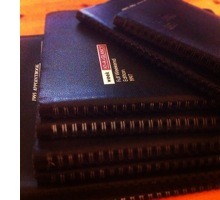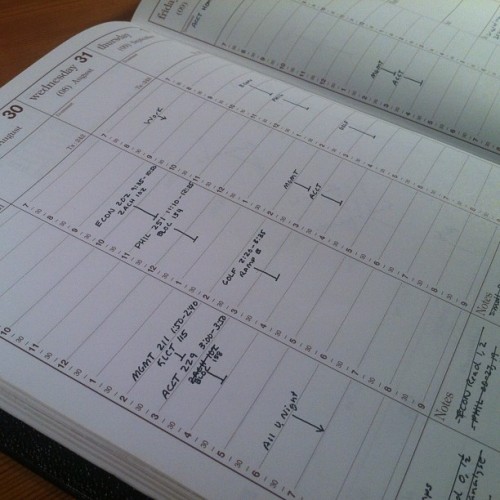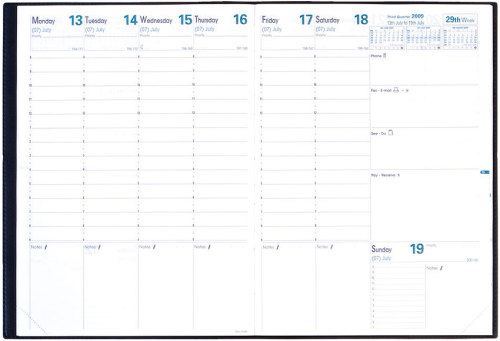“Let your mind become a lens, thanks to the converging rays of attention; let your soul be all intent on whatever it is that is established in your mind as a dominant, wholly absorbing idea.”
— Antonin-Dalmace Sertillanges
Personal Notebook
“Let your mind become a lens, thanks to the converging rays of attention; let your soul be all intent on whatever it is that is established in your mind as a dominant, wholly absorbing idea.”
— Antonin-Dalmace Sertillanges
While following a thread about Bid Data, I came across this interview with Sir David Cox, and loved this gem about problem solving (Source):
There is a well-established literature in mathematics that people who thought about a problem and do not know how to solve it, go to bed thinking about it and wake up the next morning with a solution. It’s not easily explicable but if you’re wide awake, you perhaps argue down the conventional lines of argument but what you need to do is something a bit crazy which you’re more likely to do if you’re half-awake or asleep. Presumably that’s the explanation!
Suddenly I feel a little better about falling asleep to statistics back in college.
I enjoyed this article about how productive (one of my personal heroes) Theodore Roosevelt was in a time before modern technology. (Source)
We live in an age of great distraction. Everything from Facebook and email to video games and binge TV watching can give us the sense we have done something useful with our time when, in fact, we have merely wasted a lot of days we will never get back. Many young American men, the slacker generation, would benefit from adopting Roosevelt’s “strenuous life” as a model of manhood, but it is not just a boy problem. Most of us have a slacker inside. We could do worse than to strive for the energy, disciplined time management and moral core that made Roosevelt a man worthy of a place on Mount Rushmore.
What better inspiration than that to get this blog moving again.
Perhaps it was the start of a new year or more likely the onslaught of work that hit me the day I returned from holiday, but I had an epiphany. I was being far too reactive. Why was that? I have a highly efficient process that I’ve honed after living in Microsoft Outlook for over a decade. I’m obsessive about my calendar (managed in 15 minute increments and with blocks for work and travel time) as well as achieving zero inbox on a weekly basis–much to the chagrin of my staff when the flurry of resulting emails happens on a Friday afternoon. Yet, it became apparent to me that my professional life was being dictated by what fell into my inbox and showed up on my calendar. External stimuli.
 Around the same time, I happened to come across a collection of my old datebooks from the 1990’s. I was always organized about my time and began using them in high school and through college until I got my first corporate gig which included, you guessed it, Outlook. I’m glad that I held on to them, fascinated I suppose with the idea of being able to say exactly what I was up to on a given day decades ago. Who knows, maybe they’d come in handy for my memoirs or for some future biographer when I hit it big. In any case, it was a stroke of luck that I came across them about this time.
Around the same time, I happened to come across a collection of my old datebooks from the 1990’s. I was always organized about my time and began using them in high school and through college until I got my first corporate gig which included, you guessed it, Outlook. I’m glad that I held on to them, fascinated I suppose with the idea of being able to say exactly what I was up to on a given day decades ago. Who knows, maybe they’d come in handy for my memoirs or for some future biographer when I hit it big. In any case, it was a stroke of luck that I came across them about this time.
As I flipped through the assortment, noting how much life was dominated by tests and homework, I remembered there was always one that I really liked. It’s had a great large format, pleasing layout, thicker paper and good typography. It was perfect bound but able to lay open flat. It was different from the others, which were mostly medium sized “Week At-A-Glance” full weekend editions by Keith Clark with their black vinyl covers and metal spiral binding. It wasn’t in the pile, but being larger than the rest I hoped it was just somewhere else in the storage trunk. I went frantically digging and was pleased to find it.
 Having no recollection of the brand, I discovered it was a “Quo Vadis Prenote 24 Agenda Planning Diary” from 1994 with brown print and a black vinyl cover. It shows the whole week with columns for each day except Sunday, which is squished into a small box–I hate it when they do that. It’s 8.25 x 11.5 (in contrast to the 6.75 x 8.75 “At-A-Glance” size which happen to have full Sundays, probably the reason I switched to them) with plenty of room for daily and weekly notes.
Having no recollection of the brand, I discovered it was a “Quo Vadis Prenote 24 Agenda Planning Diary” from 1994 with brown print and a black vinyl cover. It shows the whole week with columns for each day except Sunday, which is squished into a small box–I hate it when they do that. It’s 8.25 x 11.5 (in contrast to the 6.75 x 8.75 “At-A-Glance” size which happen to have full Sundays, probably the reason I switched to them) with plenty of room for daily and weekly notes.
So the next question was, do they still make these? A quick internet search found them and I was stoked. Looks like they’ve changed the typography and color palate (for the worse, sadly) but the format remains largely the same. A quick trip to an online specialty office supply store and I had one on the way ($28.44 with shipping).

So what makes these so special? It’s actually the experience of using it and the planning process it encourages. Unlike my Outlook inbox or calendar, nothing randomly shows up, I have to choose to write it in. I engage my muscle memory when writing. I become more intimate with the item I’m writing about (whether a priority, to do or appointment). This particular planner has more than just space for appointments. It has space for weekly priorities (if you repurpose the boxes on the far right) and a box for the top priorities of each day. It encourages you to think about what’s most important (or “dominant” as the 1994 version called it). It’s always providing tidbits of data like how many days or weeks remain the in the year, reminding you of the big picture.
Now I realize that with some configuration and discipline, I could make Outlook (or iCal for that matter) conform to a similar layout. But I would still loose control of what shows up. I wouldn’t get the tactile experience of writing in the book or the resulting muscle memory. Instead, I would get a backlit experience on an iPad or computer monitor during those quiet times early in the morning or late at night when natural light on paper is more contemplative (or worse, toner on loose sheets of stark white paper with horrifying typography should I conform to one of Outlook’s barely customizable print layouts).
So after a decade, we’ve divorced and I’ve found someone new. Outlook is no longer my planner. It is an input to my planner. I’m never going to avoid the flood of email or the daily meeting marathon with constantly shifting appointments that is a fact of corporate life. But by putting space between that chaos and what I write in my planner, I’m afforded the chance to consider what’s most important. To think about the rhythm of a day or a week. To be a little less quick to change priorities when something “urgent” comes in (after all, I have to actually spend a few seconds with a pencil eraser to make changes instead of just clicking a mouse).
How have the results been? Well, it’s only been two weeks so it’s difficult to factor out the potential novelty factor, but I can say with confidence I’ve been more productive. Setting daily priorities that have to fit into a 1 inch box have really made me think about what’s most important. You can only really write 2 or 3 things in there, which is usually about right for significant items. Most importantly, I enjoy the experience. It produces a more contemplative mood which I believe will lead to better planning. The muscle memory from handwriting has gotten me closer to the details of each day, and I find I actually refer to the page less because of it. I can let Outlook be Outlook and not get frustrated by trying to bend it to my needs. And, I’ll have something I can look at decades from now to see exactly what I was up to in 2012.
As a fan of having a weekly framework to drive productivity, I loved this article about Twitter Founder Jack Dorsey’s weekly routine that accommodates 2 full-time jobs… (Source)
Monday: Management meetings and “running the company” work
Tuesday: Product development
Wednesday: Marketing, communications and growth
Thursday: Developers and partnerships
Friday: The company and its culture
Weekends are a bit slower: Saturdays are for hiking and Sundays are for “reflection, feedback and strategy,” Dorsey said. But from Monday to Friday, he clocks in eight hours at Twitter and then walks two blocks over to put in another eight hours at Square.
Taking Email Etiquette to the Next Level
Not unlike publishing free/busy time from your Outlook calendar, publishing email activity in an attempt to better inform those making requests of you via email.
…it periodically checks the user’s email load based on specific measurement parameters chosen by the user – unread messages in your inbox, total number of messages in your inbox, or how much mail you’ve recently sent. After an initial 12-hour analysis, courteous.ly determines the user’s email habits and what constitutes “light,” “normal” or “high” e-mail amount. It then updates the user’s status of email volume level every 10 minutes, which is reflected in an individualized courteous.ly link.
May have to play with courteous.ly and gmail.
Not unlike publishing free/busy time from your Outlook calendar, this article discusses publishing email activity in an attempt to better inform those making requests of you via email. (Source)
…it periodically checks the user’s email load based on specific measurement parameters chosen by the user – unread messages in your inbox, total number of messages in your inbox, or how much mail you’ve recently sent. After an initial 12-hour analysis, courteous.ly determines the user’s email habits and what constitutes “light,” “normal” or “high” e-mail amount. It then updates the user’s status of email volume level every 10 minutes, which is reflected in an individualized courteous.ly link.
May have to play with courteous.ly and gmail.
A great FORA.tv program with Bill Joy that includes some gems on disruption in the marketplace, passion replacing greed (in the Gordon Gekko sense), lateral thinking and techniques for online research he uses at Kleiner Perkins. (Source)